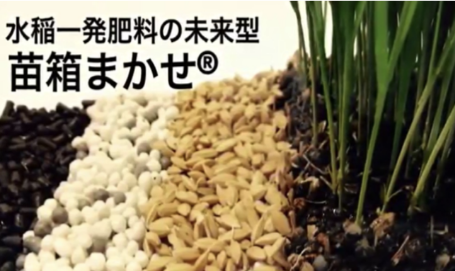

Site Search
Search within product
Video of a case study of box-applied fertilizer is now available.

2016.11.14
fertilizerJust put it in the seedling box! The ultimate in easy rice cultivation! Fertilizer exclusively for whole rice seedling box application
The "Seedling Box Makase" method of total fertilizer application to rice seedling boxes is a new technology for reducing rice fertilizer application, as described in the interim report (June 25, 2009) of the Ministry of Agriculture, Forestry and Fisheries' Study Group on Improvement of Fertilizer Application in Response to Soaring Fertilizer Prices. In other words, seedlings are placed in a seedling box and transplanted into the rice field, and in principle, no fertilizer application is required in the field until harvest. In other words, it is the ultimate in easy (=work, cost) rice cultivation.
Seedling Box Makase, a special fertilizer for whole seedling box application, is a coated fertilizer that minimizes leaching of fertilizer components during seedling growth and is the only fertilizer that can be applied in contact with the roots of paddy rice plants. As a result, the utilization rate of thiitoso components in paddy rice is outstandingly increased, enabling a significant reduction in fertilizer (approximately 10-401 TP3T in terms of thiitoso components), and the fertilizer has less environmental impact than conventional fertilization (basal fertilizer + ear fertilizer). After rice planting, as the soil temperature rises, the chisso is dissolved in accordance with the absorption of paddy rice nutrients. The stable supply of nutrients reduces uneven growth in the rice field, resulting in uniform rice growth.
In addition, the high utilization rate of paddy rice reduces fertilizer supply to weeds and suppresses weed growth. There are two methods of applying fertilizer to seedling boxes: a layered application method and a mixed application method. The brand name is N400 (containing chisso) or NK301 (containing chisso and potash), and the types are 60, 100, and 120.
*Seedling Box Makase is a registered trademark of JCAM Agri.
Seedlings using "Seedling Box Makase" (layered fertilization method)
